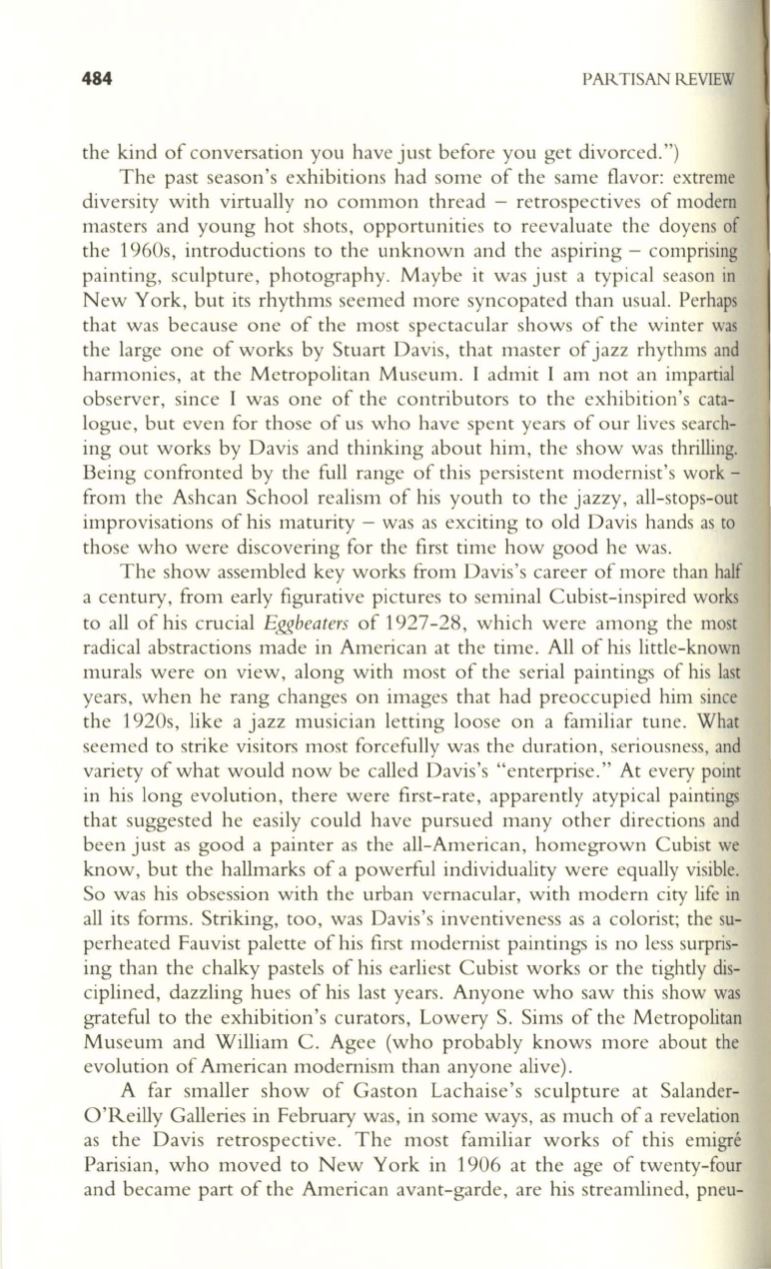
484
PAR.TISAN REVIEW
the kind of conversation you have just before you get divorced.")
The past season's exhibitions had some of the same flavor: extreme
diversity with virtually no common thread - retrospectives of modem
masters and young hot shots, opportunities to reevaluate the doyens of
the 1960s, introductions to the unknown and the aspiring - comprising
painting, sculpture, photography. Maybe it was just a typical season in
New York, but its rhythms seemed more syncopated than usuaL Perhaps
that was because one of the most spectacular shows of the winter was
the large one of works by Stuart Davis, that master of jazz rhythms and
harmonies, at the Metropolitan Museum. I admit I am not an impartial
observer, since I was one of the contributors to the exhibition's cata–
logue, but even for those of us who have spent years of our lives search–
ing out works by Davis and thinking about him, the show was thrilling.
Being confronted by the full range of this persistent modernist's work -
from the Ashcan School realism of his youth to the jazzy, all-stops-out
improvisations of his maturity - was as exciting to old Davis hands as to
those who were discovering for the first time how good he was.
The show assembled key works from Davis's career of more than half
a centuty, from early figurative pictures to seminal Cubist-inspired works
to all of his crucial
Eggbeaters
of 1927-28, which were among the most
radical abstractions made in American at the time. All of his little-known
murals were on view, along with most of the serial paintings of his last
years, when he rang changes on images that had preoccupied him since
the 1920s, like a jazz musician letting loose on a familiar tune. What
seemed to strike visitors most forcefully was the duration, seriousness, and
variety of what would now be called Davis's "enterprise." At every point
in his long evolution, there were first-rate, apparently atypical paintings
that suggested he easily could have pursued many other directions and
been just as good a painter as the all-American, homegrown Cubist we
know, but the hallmarks of a powerful individuality were equally visible.
So was his obsession with the urban vernacular, with modern city life in
all its forms. Striking, too, was Davis's inventiveness as a colorist; the su–
perheated Fauvist palette of his first modernist paintings is no less surpris–
ing than the chalky pastels of his earliest Cubist works or the tightly dis–
ciplined, dazzling hues of his last years. Anyone who saw this show was
grateful to the exhibition's curators, Lowery S. Sims of the Metropolitan
Museum and William
C.
Agee (who probably knows more about the
evolution of American modernism than anyone alive).
A far smaller show of Gaston Lachaise's sculpture at Salander–
O'Reilly Galleries in February was, in some ways, as much of a revelation
as the Davis retrospective. The most familiar works of this emigre
Parisian, who moved to New York in 1906 at the age of twenty- four
and became part of the American avant-garde, are his streamlined, pneu-


